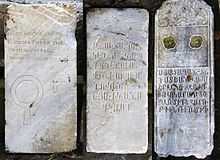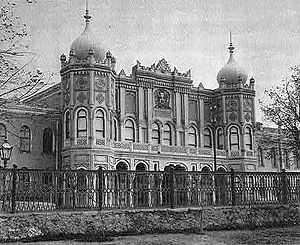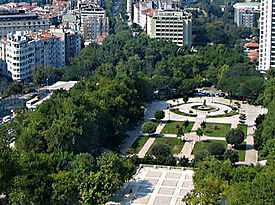Taksim Gezi Park
| Taksim Gezi Park | |
|---|---|
|
Taksim Gezi Park | |
| Type | Urban park |
| Location | Istanbul, Turkey |
| Coordinates | 41°02′18″N 28°59′13″E / 41.03833°N 28.98694°ECoordinates: 41°02′18″N 28°59′13″E / 41.03833°N 28.98694°E |
| Created | 1943 |
| Operated by | Istanbul Metropolitan Municipality |
| Status | Open all year |
Taksim Gezi Park is an urban park next to Taksim Square, in Istanbul's Beyoğlu district (historically known as Pera.)[1] It is one of the last green spaces in Beyoğlu and one of the smallest parks of Istanbul. In May 2013, plans to replace the park with a reconstruction of the former Taksim Military Barracks (demolished in 1940) intended to house a shopping mall sparked the nationwide 2013 protests in Turkey.[2]
History
The Taksim Gezi Park is located at the former site of the Halil Pasha Artillery Barracks, a large square-shaped military barracks complex with an extensive open, drill-ground, which was constructed in 1806[3] near the "Frank and Armenian burial grounds",[4][5] or the former Grand Champs des Morts.[6][7]

From 1560 to 1939 the Pangaltı Armenian Cemetery was located on the northern section of today's Gezi Park, at the vicinity of the Surp Agop Hospital.[8] The land plot of the cemetery was confiscated by the Turkish government as part of Henri Prost's plans to build Taksim Gezi Park and it was subsequently demolished in 1939.[7][9][10] In 2013, during excavations conducted for the tunnel of Cumhuriyet Avenue as part of the pedestrianization project of Taksim Square, 16 tombstones from the cemetery were discovered.[11]

Known in the 19th century as the Grand Artillery Barracks at Pera, the Halil Pasha Artillery Barracks complex (Turkish: Halil Paşa Topçu Kışlası) was built in 1806. The facade of the barracks was designed in the late Ottoman architecture, with Orientalist style details such as onion domes on the monumental entrance gates, which didn't belong to classical Ottoman architecture.[12] The barracks suffered considerable damage during the 31 March Incident in 1909.[13] The barracks, which was later transformed into Taksim Stadium in 1921, was demolished between 1939 and 1940 as part of Henri Prost's plans to build Taksim Gezi Park.
In 1936, the French architect and city planner Henri Prost (1874–1959) was invited to Turkey by President Mustafa Kemal Atatürk. He was tasked with the preparation of Istanbul's rough-cut urban planning and rebuilding, which lasted until 1951. In accordance with Prost's plans for Taksim Square, which he completed in 1939, the barracks buildings were demolished between 1939 and 1940 by the city governor and mayor Lütfi Kırdar (in office 1938–1949).[13] Prost described the place before demolition as following:
The area included the old remains of an old cemetery, several jerry-built garage buildings, a barracks in ruins, and a number of shops and cafés around the square where the monument was located.[3]
It should be noted, that in 1921 the internal courtyard of the barracks was rearranged and used as the Taksim Stadium. The Turkish national football team played their first ever official international match in this stadium against Romania on October 26, 1923, that ended up with a 2–2 draw.[13] The soccer matches were discontinued on March 25, 1940.[3]
Prost's master city plan, which came into force in 1939, provided for a much larger Taksim Gezi Park with continuous green space, which he called Park No. 2, covering an area of 30 ha (74 acres) between the neighborhoods of Taksim, Nişantaşı and Maçka extending to Bosphorus including the Dolmabahçe Valley.[3] The larger park was intended to offer green space for recreation to Istanbul's residents and tourists, but it has never been completely realized.[13]
The construction of Taksim Gezi Park was completed in 1943, and it was opened under the name "İnönü Esplanade"[3] in honor of the second Turkish president İsmet İnönü (in office 1938–1950) by Lütfi Kırdar personally. The covering area of the park diminished in later years with the construction of big hotels in the outlying zone. Nevertheless, the park remained an important recreational area within the downtown of the city, and its appearance changed to the better after restoration.[13]
2013 protests against redeveloping the site
.jpg)

From 28 May 2013 protests began to occur against plans to replace Taksim Gezi Park with a shopping mall and possible residence.[14][15] The protests developed into riots when a group began occupying Taksim square and the police tried to suppress the demonstrations.[16] The subjects of the protests have since broadened beyond the development of Taksim Gezi Park, covering issues such as freedom of assembly and freedom of expression, as well as more broadly defending the secularism of Turkey.[17] The protests also spread to other cities in Turkey, and protests were seen in other countries with significant Turkish communities.[18][19]
In 31 May 2013, police suppressed the protesters with tear gas, pressurized water.[18][19] The police action received wide attention online.[20][21]
Following the protests the Istanbul-based platform InEnArt presented Urban Voices which opens a critical view on cultural practices and phenomena that expresses the ethos, aspirations, and dreams of a specific population during a well-defined era and that triggered dramatic cultural changes in the past. One section of Urban Voices focusses on the protest culture in Turkey as described with the neologism Çapuling. It describes and reflects the visual culture, humor and irony of the peaceful protestors (the Çapulcu) as it developed in many forms in Turkey during 2013.[22]
As of 10 September 2013, a total of eight people have lost their lives in the protests: Mehmet Ayvalıtaş (20), Abdullah Cömert (22), Ethem Sarısülük (26), İrfan Tuna (47), Selim Önder (88), Ali İsmail Korkmaz (19), Berkin Elvan(16), Ahmet Atakan (22) and Police officer Mustafa Sarı (27), who fell from a bridge while in pursuit of demonstrators. A further 8,500+ were injured and twelve lost an eye, after being hit by teargas grenades and police's interventions.[23] Police received widespread criticism for, among other things, using tear gas within buildings. The Koç Group, which had supported the demonstrators by giving them sanctuary in one of their hotels near Taksim was then subject to a tax investigation.
Gallery
- Taksim Gezi Park
-

Taksim Gezi Park (March 2013)
-
Taksim Gezi Park (March 2013)
-
Taksim Gezi Park (March 2013)
-
Taksim Gezi Park (March 2013)
-
Taksim Gezi Park (March 2013)
-
Taksim Gezi Park (March 2013)
-
Taksim Gezi Park (March 2013)
See also
References
- ↑ "Photos of Istambul". www.maggieblanck.com. Retrieved 2013-06-19.
- ↑ "Turkey protests spread after violence in Istanbul over park demolition". The Guardian. 31 May 2013. Retrieved 1 June 2013.
- ↑ 3.0 3.1 3.2 3.3 3.4 Yildirim, Birge, Istanbul Technical University. "Transformation of public squares of Istanbul between 1938-1949" (PDF). 15th International Planning History Society Conference. Retrieved 2013-06-19.
- ↑ Murray, John. A (1845). A Hand-Book for Travellers in the Ionian Islands, Greece, Turkey, Asia Minor, and Constantinople: Being a Guide to the Principal Routes in Those Countries, Including a Description of Malta : with Maxims and Hints for Travellers in the East. London: J. Murray.
- ↑ The Select Circulating Library Containing the Best Popular Literature, Including Memoirs, Biography, Novels, Tales, Travels, Voyages, & C, Part II. Philadelphia: Adam Waldie. 1837. p. 313.
- ↑ Johnson, Brian (2005). "Istanbul's Vanished City of the Dead: The Grand Champs des Morts". The Fountin. January - March (49).
- ↑ 7.0 7.1 "In Istanbul’s Heart, Leader’s Obsession, Perhaps Achilles’ Heel". The New York Times. 2013-06-07. Retrieved 2013-06-27.
- ↑ Google Earth: Map of Taksim Gezi Park, showing its northern and southern sections
- ↑ "Taksim protestors state "We All are Hrant Dink, We All are Armenians"". Armenpress. 2013-06-06. Retrieved 2013-06-06.
- ↑ Greenhouse, Emily (June 28, 2013). "The Armenian Past of Taksim Square". The New Yorker.
- ↑ ERTÜRK, Ali Ekber (29 June 2013). "Taksim’de Ermeni mezarları çıktı". Aksam (in Turkish).
- ↑ De Amicis, Edmondo. (2005). Constantinople. London: Hesperus, p. 42.
- ↑ 13.0 13.1 13.2 13.3 13.4 "Taksim Gezi Parkı'nın Tarihçesi". Aktif Haber (in Turkish). 2013-06-01. Retrieved 2013-06-91. Check date values in:
|accessdate=(help) - ↑ Xypolia, Ilia (2013). Gokay, Bulent; Xypolia, Ilia, ed. Turmoils and Economic Miracles: Turkey '13 and Mexico '68 (PDF). Keele, UK.: Keele European Research Centre. p. 33. ISSN 1363-8165.
- ↑ "Police use tear gas early in morning, Taksim park protesters again halt demolition". Good Morning Turkey. 31 May 2013. Retrieved 3 June 2013.
- ↑ http://www.ejolt.org/2013/06/turkeys-tree-revolution-part-2-everyday-im-chapulling/ Turkey’s Tree Revolution – part 2: Everyday I’m chapulling - EJOLT 12 June 2013- retrieved 30 August 2013
- ↑ "Fresh anti-government clashes hit Turkey". Al Jazeera. 1 June 2013. Retrieved 1 June 2013.
- ↑ 18.0 18.1 "Turkey arrests anti-government protesters". Al Jazeera English. 31 May 2013. Retrieved 1 June 2013.
- ↑ 19.0 19.1 Tattersall, Nick (1 June 2013). "Turkish PM calls for immediate end to protests as clashes flare". Reuters. Retrieved 1 June 2013.
- ↑ "Protesters #OccupyGezi to save Istanbul park". Al Jazeera. 31 May 2013. Retrieved 1 June 2013.
- ↑ "Ünlüler Gezi Parkı ile ilgili Twitter'da neler söyledi?". Radikal. 31 May 2013. Retrieved 1 June 2013.
- ↑ "Chapulling". InEnArt. Retrieved 25 June 2013.
- ↑ Medyatava: "Gezi protestolarında ölen 7 kişi için 7 ülkede, 7 kişi, 7 dakika durdu!" (29/07/2013)
Further reading
- Gokay, Bulent and Xypolia, Ilia (eds.) (2013) Reflections on Taksim -Gezi Park Protests in Turkey. Keele European Research Centre: Keele, UK. (PDF)
External links
| Wikimedia Commons has media related to Taksim Gezi Park. |






